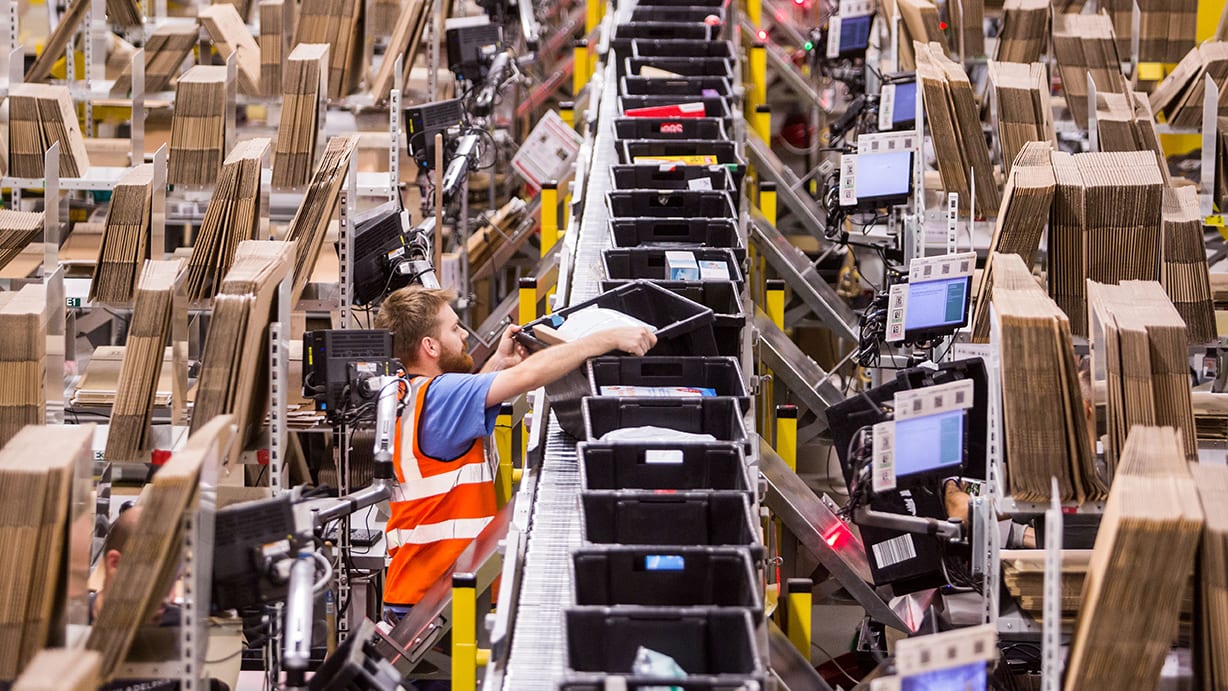Has the Push for Productivity Gone Too Far?
Employers are constantly pressuring workers to produce more and faster. But there are signs of strain.
A mantra is posted everywhere at Amazon’s fulfillment center in Kenosha, Wis.:
Work hard. Have fun. Make history.
Indeed, employees at the distribution hub 65 miles north of Chicago appear to be working hard—certainly maintaining a brisk pace—as they pick and pack orders near wheeled robots and display screens. A network of conveyor belts whisks sealed boxes toward cargo bays, where a worker hand-fits the boxes into trailers.
An Amazon tour “ambassador” likens this last part to Tetris, the video game in which players try to maneuver block formations into airtight stacks.
“We want to ship packages, not space,” he tells visitors.
To an outsider, the Wisconsin operation looks immaculate, efficient and even kind of fun. But the reality may well be different for Amazon workers. News reports have raised issues about the company’s blend of proprietary software, automation and human labor.
Some past and current Amazon employees have said they face unyielding pressure to “make rate” or face termination. In April, The Verge reported that computers can flag warehouse employees to be fired based on their individually tracked performances; Amazon insists human managers can intervene and help workers get the coaching they need.
The company’s widening footprint on U.S. commerce and its sometimes-contentious relationship with employees highlight the delicate balance that HR professionals seek in helping business leaders achieve their financial goals while also protecting the health and well-being of their employees.
‘Nobody’s doing a lot of research on the psychological toll of being under that level of surveillance and that level of pressure to work quickly under threat of being fired by the computer.’
Beth Gutelius
“A lot of these employers that really push on productivity don’t recognize the cost of constantly replacing people,” says Pittsburgh-area consultant Bill Thomas, SHRM-SCP, managing principal of Centric Performance LLP and a member of the Society for Human Resource Management Special Expertise Panel on HR Disciplines. “If they step back to think a minute, it’s a pretty costly proposition to have that kind of churn.”
Companies typically face competitive pressures within their regions to keep working conditions and wages at acceptable standards, says Thomas, who works with industrial companies. However, in economically depressed areas, “there’s not much incentive for the employer to worry about striking a middle ground. They’re going to take the approach that ‘Hey, this is the best job around. Take it or leave it.’ ”
With their focus on both business goals and the well-being of the workforce, HR professionals are in a unique position to help their organizations achieve the best outcomes.

The Toll
Manufacturers have been scrutinizing productivity levels—and examining weak links in the chain—since the first moving assembly lines began operating more than a century ago. Before that was Frederick Taylor’s system of “scientific management,” which examined the components of industrial shops to quicken workflows.
Technology to monitor employees has also been around for a while. Decades ago, security guards turned keys in “watchclocks” to verify that they made their nightly rounds. For years, drivers for delivery companies such as UPS and FedEx have been tethered to barcode scanners. Today, their vehicles are rigorously tracked to make sure they’re staying on course and on time.
 “You don’t get in the truck and figure out where you’re going to go,” says productivity expert Robby Slaughter, founder of AcelaWork, a consortium of business consultants based in Indianapolis. “You’re told exactly where to go and when to turn via GPS. And if you’re off even a tiny percentage and you can’t justify it, you get in trouble.”
“You don’t get in the truck and figure out where you’re going to go,” says productivity expert Robby Slaughter, founder of AcelaWork, a consortium of business consultants based in Indianapolis. “You’re told exactly where to go and when to turn via GPS. And if you’re off even a tiny percentage and you can’t justify it, you get in trouble.”
What’s new is the way Amazon compiles granular metrics about workers and subjects them to demanding computer algorithms, says Beth Gutelius, a senior researcher at the Great Cities Institute at the University of Illinois-Chicago.
“We have to consider the physical toll and the mental toll,” she says. “They’re linked, but the mental toll gets much less attention. Nobody’s doing a lot of research on the psychological toll of being under that level of surveillance and that level of pressure to work quickly under threat of being fired by the computer.”
Gutelius thinks Amazon, which she calls the influential “first mover,” is creeping toward a system of near-total automation. Workers who have a stake in that transformation should be heard, she says.
“Without any kind of input on the development of labor standards on the part of people who will actually be underneath those labor standards, I think we’re going to run into trouble,” she says.
Slaughter also advocates for involving employees whose lives will be changed by technology. “Otherwise,” he says, “you risk disenfranchising them and disconnecting them and creating more problems for yourself.”
Amazon didn’t respond to requests for comment for this article, beyond offering some information about its fulfillment centers. (For example, during holiday-related peaks, a location like Kenosha is able to move more than 1 million items in a 24-hour period.)
The Verge report about Amazon computers being able to effectively fire slower workers suggests that human supervisors are being supplanted by artificial intelligence (AI). This makes some HR professionals uneasy.
Managers play a crucial role in unlocking the full productivity of individual workers, says Gayle Troy, SHRM-SCP, former HR manager for Globe, a firefighter garment manufacturer in Pittsfield, N.H. “They have to coordinate and balance and coach and train, and they have to discipline, when necessary, if people aren’t meeting expectations,” she says. “You have to be genuinely concerned about both your employees and the company.”
When Nature Calls
Impromptu trips to the bathroom taken outside of scheduled breaks or lunches can pose a challenge, especially in a manufacturing setting, several HR professionals agree.
The issue of closely monitored bathroom breaks has dogged e-commerce giant Amazon, which tracks the productivity of workers at an unprecedented level. Some warehouse workers in the United Kingdom resorted to relieving themselves in bottles, rather than taking the time to walk to restrooms and risk accumulating disciplinary points, according to James Bloodworth’s book Hired: Six Months Undercover in Low-Wage Britain (Atlantic Books, 2018). Amazon has denied those allegations.
Restroom access is central to a federal lawsuit filed on behalf of a former Amazon call center employee in Winchester, Ky. Nicholas Stover said he was fired for spending too much time in the bathroom, even after he provided the company with medical documentation noting that he has Crohn’s disease, an inflammatory bowel disorder.
The lawsuit alleges that Amazon, with its “unyielding and inhuman policies governing bathroom access,” failed to make a reasonable accommodation for Stover, as required by the federal Americans with Disabilities Act (ADA). The complaint says an HR manager told him that if the company made an exception for Stover, it would have to do the same for everyone.
Amazon didn’t respond to a request for comment on the ADA-related lawsuit.
Evan Stall, an HR manager for DRiV Incorporated, says an employer is obligated only to try to accommodate the worker with the disability.
“We have to work with them and determine if there’s reasonable accommodation without undue hardship,” he says.
At the Indiana auto-parts factory where Stall used to work, an employee with epilepsy was able to remain at the plant under an arrangement worked out with managers. The employee was stationed away from heavy machinery and agreed to wear a hard hat on the floor. The worker also took medication to offset potential seizures, he says.
Eric Emerson, SHRM-CP, HR manager for Value Added Products Cooperative, advises using common sense and flexibility. His company makes wholesale pizza crusts via a sometimes fast-paced production line.
“We’re grown adults, and we know when we have to go to the bathroom and when we can hold it a little longer,” Emerson says. “If you say, ‘Hey, I’ve got to go to the bathroom,’ they’ll have somebody rotate into your spot for a few minutes while you run to the restroom.” —M.R.
Objective Measures
Steve Kraus, vice president of marketing for Boston software developer Cogito, agrees with Troy’s assessment. But he maintains that AI can enhance the traditional relationship between employees and supervisors.
His company, which counts MetLife and Humana as clients, has developed a platform based on behavioral research that analyzes conversations between call center agents and customers. The program uses onscreen prompts to suggest ways agents can be more effective. For example, it may advise them to talk in a more empathetic way or to not interrupt the customer. 
“I always cringe when I hear terms like ‘monitor’ and ‘judge,’ ” says Kraus, who prefers the word “nudge” to describe the software’s effects. “You’re giving the agent the tools to manage that conversation like a professional. People talk a lot about empathy. You want them to be empathetic with a customer, but you don’t want them to take on the customer’s burden.”
He says Cogito depressurizes the workplace because managers aren’t looming over employees as much. Additionally, performance reviews are no longer based on a few recorded phone calls.
“When [employees] actually meet with their supervisors now, they’re both talking about very objective, transparent data that they didn’t have before,” Kraus says.
There’s no denying that monitoring software can help managers, says Aaron Burciaga, the Virginia-based chief technology officer for data firm Analytics2Go. He has used a program to make sure members of his team in Brazil are staying on task.
“The limitations are going to be what the market can bear—what the employees will sign up for,” Burciaga says.
Beth Galetti, Amazon’s senior vice president of human resources, has said it’s not feasible for the employer to do things in conventional ways.
“If we’re going to hire tens of thousands—or now hundreds of thousands—of people a year, we can’t afford to live by manual processes and manual transactions,” said Galetti, a former FedEx executive with logistical expertise, in a Fast Company magazine interview earlier this year.
In terms of employee benefits, Amazon last year raised the company’s minimum wage to $15 an hour. It offers onsite vocational classes at some of its facilities, including Kenosha; those classes can help employees land jobs in other fields. In July, Amazon announced a $700 million retraining program for one-third of its U.S. workforce as technology and automation changes the nature of many jobs. For full- and part-time employees who want out immediately, the company offers individual cash payments of up to $5,000 to walk away, The Atlantic reported.
Indeed, Amazon may not be the right employer for everyone, says consultant Joe O’Brien, former HR manager for precision manufacturer Oberg Industries in Freeport, Pa. People might not have the right skill set to advance, he says, or they might not feel inspired in automated environments.
Workers ‘don’t want to be treated as an extension of the widget they make. They want to be looked at as somebody who has a mind and has values they can contribute.’
Bill Thomas, SHRM-SCP
Companies should be upfront about the potential trajectory of employees’ careers and the role that automation is expected to play in the years ahead, so that individuals can determine whether they have a future there, O’Brien says.
“I’ve had hourly workers say, ‘How do I get ahead?’ ” he says. “The ideal state would be to have a culture that has a broad enough net to attract and retain people. Those who have eyes to see the opportunity will also cooperate to try to enhance their own skills so that they can go up the food chain.”
Insofar as Amazon or any company keeps employees informed about productivity, that’s a good thing, industry veterans say.
 Evan Stall, SHRM-CP, an HR manager for DRiV Incorporated near Detroit, says an Indiana auto-parts plant where he previously worked was equipped with electronic boards, and, in real time, the screens tallied the number of items employees had produced versus the goal for that day.
Evan Stall, SHRM-CP, an HR manager for DRiV Incorporated near Detroit, says an Indiana auto-parts plant where he previously worked was equipped with electronic boards, and, in real time, the screens tallied the number of items employees had produced versus the goal for that day.
“For the people on the line, it can either be highly motivating or it can be a source of a lot of pain,” Stall says. “But it is highly visual. They know exactly how it’s going.”
Thomas, the Pittsburgh consultant, says businesses also cannot underestimate the power of human interaction when dealing with workers.
“They don’t want to be treated as an extension of the widget they make,” he says. “They want to be looked at as somebody who has a mind and has values they can contribute.”
How to Help
Preventing employee burnout helps a company’s bottom line, says Rob Wilson, employment expert and president of Employco USA in Westco, Ill.
One million workers skip work each day because of the physical and emotional stress of employee burnout, which is estimated to cost employers almost $300 billion annually.
“Common job stressors include a heavy workload, intense pressure to perform at high levels, job insecurity, long work hours, excessive travel, office politics and conflicts with co-workers,” Wilson says.- To help reduce employee stress and, in turn, improve health, morale and productivity, he suggests the following:
- Make sure that workloads are appropriate.
- Require managers to share information with employees regularly.
- Address inappropriate and illegal actions immediately. Don’t tolerate bullying, discrimination or similar negative behaviors at work.
- Celebrate employees’ successes, increasing morale and decreasing stress.
- Encourage work/life balance.
- Ensure that employees can take paid time off.
- Promote exercise, which is a proven stress reliever.
- Plan activities to give employees a reason to take a break.
- Train managers on how to keep employees engaged and motivated.
Money Helps
And then there’s compensation, a no-brainer where employee motivation is concerned, experts say.
In an effort to make jobs at Value Added Products Cooperative in Alva, Okla., more attractive, the pizza-crust maker revamped its wage tiers and increased pay rates, says HR Manager Eric Emerson, SHRM-CP.
That, coupled with the revival of an annual review system for workers, has greatly improved the company’s turnover rate. It dropped from 143 percent in 2017 to 80 percent in 2018, and to about 25 percent so far in 2019, he says.
“Human resources is just customer service, and your employees are your customers,” Emerson says. “You’re selling them a job, though it’s incumbent on you to sell them a job that they want to purchase with their labor hours. Conversely, you’re their customer, so it’s incumbent on them to provide you with a labor product that you want to buy.”
Troy recalls that Globe, which produces about 120,000 firefighter garments annually, tracked several aspects of productivity, including quality and efficiency. These metrics drove a “layered incentive” system that financially rewarded workers for individual and group benchmarks, she says.
“We have to think ‘What is good for the company?’ and then ‘What is good for the employee?’ ” Troy says. “It can be very different things, so we have to work that out together.”
Mike Ramsey is a Chicago-based freelance writer.
China's '996': A Global Competition?
U.S. workers may gripe about the number of hours they’re expected to put in, but they have it better than some of their counterparts in China, where business leaders are openly pushing a system known as “996.”
Employees at Chinese startups are expected to work from 9 a.m. to 9 p.m., six days a week, for a grand total of 72 hours. The work ethic has been endorsed by Jack Ma, co-founder of e-commerce giant Alibaba, Asia’s equivalent of Amazon, and some of his entrepreneurial peers.
“I personally think that 996 is a huge blessing,” Ma said in a controversial blog post earlier this year, according to a CNN report. “How do you achieve the success you want without paying extra effort and time?”
Tech workers and even state-run media in China have pushed back at the idea, saying employees could literally work themselves to death. Critics also say workers have little quality of life when they’re so snowed under.
Still, 996 is likely to prevail, says business journalist Rebecca Fannin, author of Tech Titans of China (Nicholas Brealey, 2019), which examines the cultures of these companies.
“As long as China’s economy is growing as fast as it is and as long as the startups and tech are growing as fast as they are, I think it is going to stick,” Fannin says. “That’s pretty accepted, that’s the work pace, and work is your life.”
Observers agree that the Chinese model will put competitive pressure on U.S. companies and their employees, but they doubt 996 will gain traction here. For one thing, U.S. labor laws are markedly stricter. Some also challenge the assumption that extra hours guarantee success.
One thing that separates a high-performing company from the others is it doesn’t focus on doing more—it focuses on better results, says consultant Bill Thomas, SHRM-SCP, managing principal of Centric Performance.
“You can spend more time on the clock, you can do 996, but that doesn’t mean the quality’s going to be there or the output you need is going to be there,” he says. —M.R.


